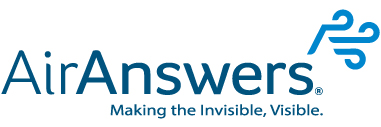AirAnswers® Device Detects and Quantifies Coronavirus (COVID-19) as Confirmed in University of Chicago Study
AirAnswers® is being used in a University of Chicago Study to confirm the presence of COVID-19 in hospitals and identify how far the virus can travel.
“Interviewer: We now know that COVID-19 particles are in the air, we just don’t know how far they spread or how contagious the virus can be. Dr. Pinto is lead a study at the University of Chicago to answer those questions and joins us via Skype. Thank you for being with us”
Dr. Jayant Pinto: Happy to be here.
Interviewer: We are told to keep six feet of distance between ourselves and others, that’s not based upon what we know on this virus. Where does that recommendation come from?
Dr. Jayant Pinto: That recommendation comes from older studies based on how far sneezes and coughs travel and is informed by old studies of Tuberculosis. There have been recent studies looking at simulations of particles out of the airway to inform the distance.
Interviewer: How do you measure a virus’s reach?
Dr. Jayant Pinto: We are using an air sampler in the hospital, which collects material that is in the air, and we put it at a certain distance from the patient’s bedside to learn that if patients who are in the ICU who are very sick, how much virus are they putting out in the air and where do you detect it in the hospital room so we can protect our healthcare team.
Interviewer: What exactly will you be able to do with that information that you generate from the study?
Dr. Jayant Pinto: So, we’ll be able to know how the virus travels in the air and hospital. That will allow us to design preventive measures and specific protocols to protect our teams. We’ll also be able to use that information to design studies in the future who examine this question in other environments. For example, in the emergency room, in the clinic, and eventually out in the regular parts of the city and in the home.
Interviewer: Well could you project how your study results might affect how schools approach reopening in the fall?
Dr. Jayant Pinto: It’s a great question, I think we can replicate those results in other real-world scenarios. Can they go back to school and can they be safe? I think we’ll be able to get some limited information in the hospital setting and we’ll have to do further studies to see if we can replicate those results in other real-world settings but we’ll be able to have some information on distance, at least in very sick patients in the ICU in the hospital and that will allow us to learn some more about this virus and how it’s spread.
Interviewer: Dr. Pinto when do you expect to have that information, that data?
Dr. Jayant Pinto: Well, we’re starting the study now. We have some exciting preliminary results that we can actually detect the virus in the air. We weren’t sure we’d be able to do that and we hope to have some preliminary findings in about a month.”
View more videos about AirAnswers® being using to detect COVID-19 by clicking the links below:










